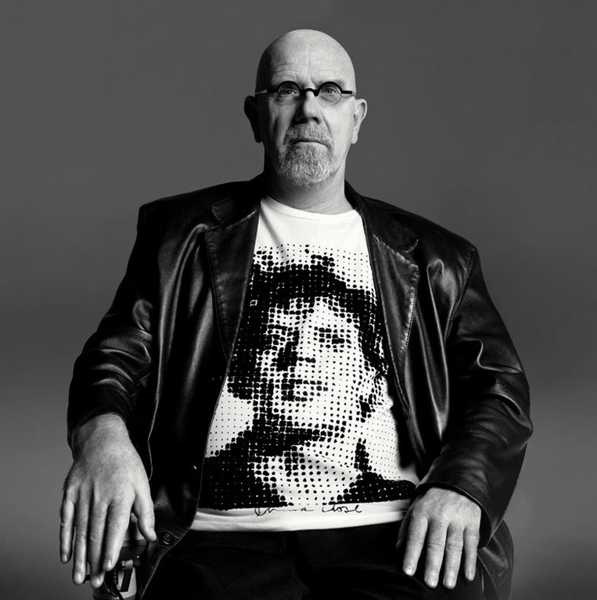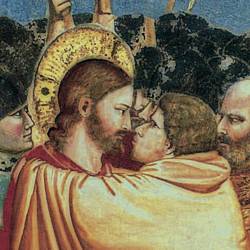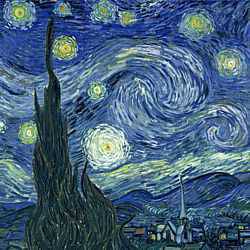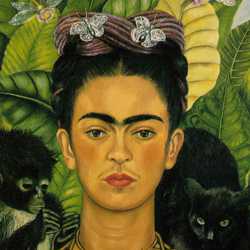Paintings by Chuck Close
Chuck Close is a modern American artist who has achieved international recognition for his large scale portraits of himself, his friends and his family.
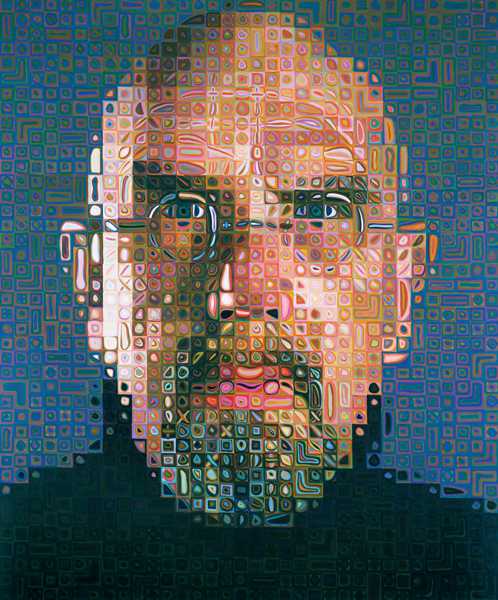
Chuck Close (1940-2021)
'Self Portrait', (2004-05)
oil on canvas (102"x86")
Chuck Close is a modern American artist who has achieved international recognition for his large scale portraits. He was instrumental in reviving the art of portraiture as a credible subject matter at a time when figurative art looked dead in the water.
Chuck Close: His Artistic Development
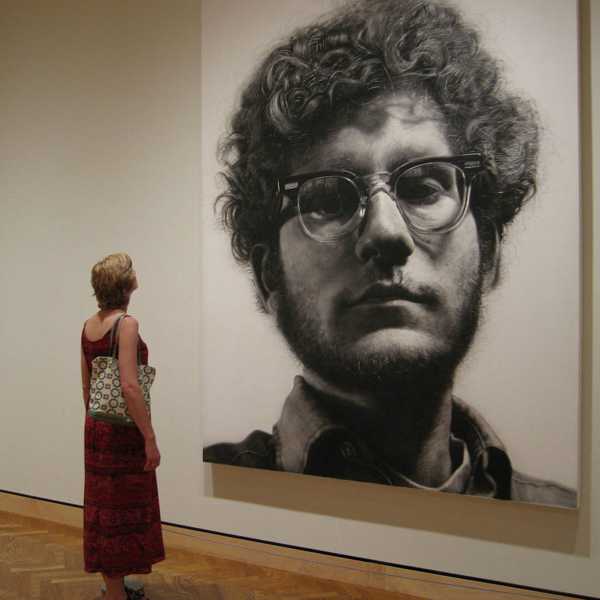
Chuck Close (1940-2021)
Frank, 1969,
acrylic on canvas (108"x84")
The history of Western art has evolved by artists either developing the art of previous generations or reacting against it. As an emerging artist in the 1960's Chuck Close had grown up against the backdrop of Abstract Expressionism, the first major art movement to come out of America. Like many young artists he explored the established visual language of the day which he absorbed into his work but eventually rejected in his search for a personal style. In a dramatic switch from abstract to figurative painting, he abandoned the freedom of Abstract Expressionism in favour of more restrictive controls on both his subject matter and painting technique. He began to work on large scale monochrome portraits in a Photorealist style, although the term had not yet been invented.
The subjects of his portraits are drawn from himself, his family and friends (most of whom are fellow artists). He chose this select group for their anonymity as any recognition of celebrity in his subject matter, such as exists in a Warhol portrait, would distract the spectator from the aesthetics of the work. To reinforce this relationship he titles all his portraits with the subject's first name only and he also refused commissions on the grounds that "Anyone vain enough to want a nine-foot portrait of themselves would want the blemishes removed."
Chuck Close: Big Self Portrait

Chuck Close (1940-2021)
'Big Self Portrait', (1967-68)
acrylic on canvas (107.5"x83.5")
Big Self-Portrait', a massive 9ft high painting of a head around fifty times life-size, characterizes Chuck Close's early work. It is painted 'with about half a teaspoon of black paint' which is thinned down to the consistency of dirty water and applied with brushes and an airbrush. The mesmerizing details are created by scraping with razor blades to depict the sharper areas of definition and rubbing with an eraser attached to an electric drill for the softer blends of tone.
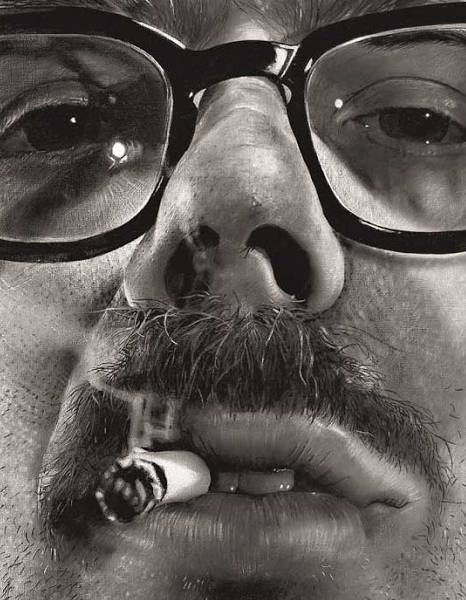
Chuck Close (1940-2021)
Detail of 'Big Self Portrait', 1967-68
The large scale of this portrait is important as it allows the viewer to interact with the work in different ways. The artist states, "I don't want the viewer to see the whole head at once and assume that that's the most important aspect of my painting". You can read the painting in different ways depending on where you are standing in the room. From a distance it is indistinguishable from a high resolution photograph. Up close it is more difficult to scan and takes on the ambiguous characteristics of a landscape or abstract painting. It is both easy and fun to alternate your readings of the image but neither detract from the breathtaking impact of the work.
Chuck Close: Using the Grid

Chuck Close (1940-2021)
Source image for 'Big Self Portrait'
Chuck Close has grown to believe that his work is driven by his lifelong learning difficulties such as dyslexia and prosopagnosia (the inability to remember faces). He feels he was compelled to make portraits by his need to commit faces to memory. His learning difficulties also provide a key to his working methods. He uses a grid to break down every image that he paints into small incremental units so that he can comfortably focus on each part to avoid being overwhelmed by the whole. Consequently, no problem becomes too big to be solved. You no longer need worry about drawing the entire face as you can tackle it incrementally, one bit at a time until the whole image is complete.
Close works from Polaroid photographs on which he overlays a grid to divide the image into small sections that he methodically scales up and painstakingly paints inch by inch onto a large canvas. To describe the process he draws a parallel with 'knitting' as he builds up the work row by row. The result is a photorealistic image of a face but it also becomes its own account of how it was made with every square inch of the painting as significant as every other. He states that "likeness is an automatic by-product of what I do.......the fact that it ultimately stacks up to build an image which has any relation to reality is mystifying to me".
Chuck Close: The Concept of 'All-overness'
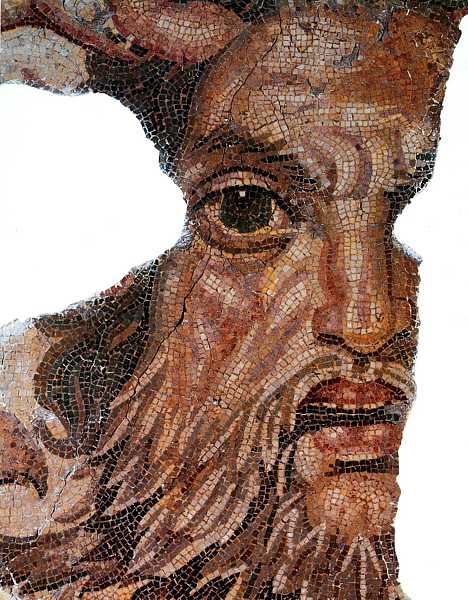
Fragment from an ancient Roman mosaic.
Chuck Close's preoccupation with the overall unity of surface is a fundamental quality that marks all his work. 'All-overness', where all areas of the composition are given equal emphasis, was an element that he admired in Abstract Expressionism, particularly in the work of Jackson Pollock and Willem De Kooning. It is a compositional preference that has its modernist heritage in Surrealist automatism, the fractured reconstructions of Cubism, the Neo-impressionist styles of Pointillism and Divisionism and the unified brushwork of Cézanne. It also has its historical ancestry in art as diverse as ancient Roman mosaics and Aboriginal dot paintings.
Chuck Close: 'The Event'

'Chuck Close working on a Self Portrait' (2004-05)
© Walker Art Center
Since he was a child in Monroe, Washington, Chuck Close had always developed creative strategies to accommodate his learning disabilities. At school he discovered that art was the one thing that gave him a sense of identity. It was what others responded to in him and it was what he felt he was born to do. He later studied for a BA at the University of Washington in Seattle and an MFA at Yale where he graduated in 1964. By the 1980's he had grown into an artist of national stature. Tragically, on December 7th 1988 he was struck by a devastating affliction that he now refers to as the 'Event' - he suffered a spinal stroke which left him paralysed from the neck down and dependant on a wheelchair for mobility.
Close has always been the type of person who reacts positively to adversity and his response to the 'Event' proved no exception. The thought of giving up art was never an acceptable option. Motivated by the determination to paint again, he endured endless hours of physical therapy which helped him to regain some use of his hands and arms. He used a splint to enable him to hold a paintbrush and a mechanized easel to raise lower and rotate his canvas to a suitable position for painting.
Prior to the 'Event', Close had been accustomed to applying self-imposed limitations as a creative parameter in his art and he had developed various techniques and methods of mark making that worked within his style. As a result of the 'Event' he was forced to adapt his working method to accommodate his restricted movement. It was never a question of starting again; it was more a matter of finding a new vocabulary of marks that could express his vision within the limitations of his disability.

Chuck Close (1940-2021)
'Alex II' with close-up detail (1989)
Oil on canvas (36"x30")
The first painting that Chuck Close completed during his rehabilitation was 'Alex II' (1989). This is a tentative study of his friend, the artist Alex Katz, based on a black and white Polaroid photograph taken two years earlier. Although he was painting portraits in a similar style before the 'Event', his brushwork is now less constrained by the grid and his color palette is more dynamic. As this work is based on a monochrome image, his choice of colors is obviously subjective. The use of strong complementary hues is as much a statement that reflects his conflicting emotions as it is an attempt at optical accuracy. This is a massively courageous picture and given the context it could be seen as one of Close's greatest works. All great portraits tell you more about the artist than they do about the sitter. Alex Katz may be the sitter but the real subject of this work is Close's personal battle to regain his artistic confidence.
Chuck Close: 'The Beat of the Grid'

Chuck Close (1940-2021)
'James' with close-up detail (2004)
Screenprint (62"x48")
Close experimented with the effect of the grid in his art, sometimes applying it horizontally, sometimes diagonally and sometimes rotating it around a point. He employs it as an important compositional device to structure his image and not merely as a method for scaling up his photographic source material. Its scale and placement in relation to the image is crucial as he searches for what he calls 'the beat of the grid' - the configuration of increments that breaks up the image in the most interesting manner. In general, the size of his grids have increased over time resulting in a lower resolution image but amplifying the abstract qualities of color and pattern. Therefore, what he loses in descriptive detail he gains in the colorful impact of each individual section.
Although Close's early black and white heads worked on different levels, you had to take an imaginative leap to engage with alternative readings of the image. The use of the grid was implicit and not obvious enough in the final work to awaken your consciousness to the conceptual content of the process. With the works that he has created since the 'Event', his use of the grid is more explicit. He controls the viewers interaction with the image in a more measured way. An increased focus on his vocabulary of marks and colors lends more emphasis to an abstract reading of the image and heightens your awareness of the grid as a structural element. This results in a better balance between the representational, abstract and conceptual qualities of the work.
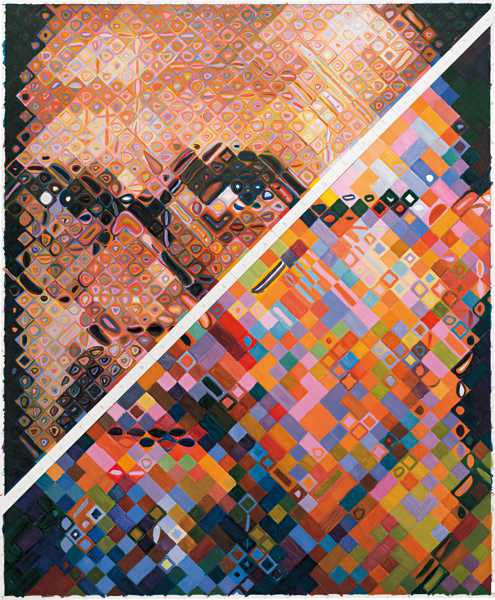
Chuck Close (1940-2021)
'Self Portrait' in progress (1997)
oil on canvas, (102"x84")
Chuck Close's working method is quite remarkable. Unlike most artists he only engages with the image close up and does not move back to view the work from a distance. This means that he not only places complete trust in his technique but that he also possesses an extraordinary understanding of the effects of color.
When he starts to paint a portrait he applies a background color to each individual section of the grid. The colors that he chooses have a similar tonal value to their corresponding section on the grid. He then starts to fill each section with four or five freely painted outlines of different colored forms. He draws these from a vocabulary of simple shapes that include squares, triangles, right-angles, doughnuts, lozenges and 'hotdogs'. Each small section becomes an abstract color study whose hues mix optically to create a 'visual chord'. Years of experience have taught him how this 'chord' will read from a distance and how it will combine with adjacent sections to form the tones and colors of the head. There is a certain irony that someone who started out creating uncompromisingly monochrome images should develop into such an outstanding colorist.
Some critics have attacked Chuck Close due to his use of photography and his grid-oriented approach as they feel his work is too prescriptive. Would they make the same criticism of Claude Monet whose landscapes were influenced by photography and whose serial images of Haystacks and Rouen Cathedral have become touchstones of modernism? In its own way, Close's work is a contemporary development of that tradition. He takes pains to stress that his art 'is found, it’s felt, it’s arrived at, and it’s not some mathematical overlay.' As Monet analyzed his subject matter and reconstructed its form through the prismatic spectrum of Impressionist color, Chuck Close uses the same intuitive eye to analyze and reconstruct the subject of his art, what he refers to as 'the road map of the face'.
Chuck Close: His Range of Techniques

Chuck Close (1940-2021)
'Phil Fingerprint / Random' with close-up detail (1979)
Fingerprints with stamp-pad ink (40"x26")
Close also applies his creative process through a wide range of techniques and materials including acrylic, oils, watercolor, drawing, pastels, printmaking, collage, tapestry, photography, CYMK color separations, digital imaging, rubber stamps, fingerprints, paper pulp and string. Any unit that can be reproduced incrementally, such as his fingerprints which were printed again and again to create the image of 'Philip' above, is a suitable component for his artistic process.
Art critics have tried to classify him as a Photorealist because his portraits are not from primary sources but are based on large Polaroid photographs; as a Pop Artist due to the scale, impact and the time frame of his work; and as a Conceptual Artist due to his process based approach. In truth he is all and none of these. Chuck Close is simply an outstanding artist who does not sit comfortably in any 'ism' as his vision is informed by a wide range of influences and his unique personal circumstances.
All paintings illustrated © Chuck Close
Chuck Close Notes
Chuck Close (1940-2021) was a modern American artist who is famous for his massive portraits of his family and friends.
-
He worked from large Polaroid photographs of his subjects.
-
He helped to revived the art of portraiture at a time when abstract art was all the rage.
-
His early works are painted in black and white in a Photorealist style.
-
He was influenced by many different styles and techniques from Pop Art to Pointillism to ancient Roman mosaics.
-
He used a grid to divide the image into small sections which he scaled up onto a large canvas.
-
His later work uses the grid as a structural element in the composition.
-
Due to their large scale, Chuck Close's paintings can be read in different ways: up close each section of the grid becomes a small abstract color study; from a distance all the sections of the grid combine to create a realistic portrait.
-
His artworks are a careful balance between the representational, the abstract and the conceptual qualities of the image.
-
Chuck Close had learning difficulties such as dyslexia and prosopagnosia (the inability to remember faces) which had a major influence on his style.
-
In 1988 he suffered a spinal stroke which left him paralysed from the neck down and dependant on a wheelchair for mobility. He referred to this as 'The Event'.
-
After the 'Event' he was determined to continue with his painting despite the limitations of his disability.
-
He used a splint to enable him to hold a paintbrush and a mechanized easel to raise, lower and rotate his canvas to a suitable position for painting.
-
Chuck Close worked in a wide range of techniques and materials including acrylic, oils, watercolor, drawing, pastels, printmaking, collage, tapestry, photography, CYMK color separations, digital imaging, rubber stamps, fingerprints, paper pulp and string.

